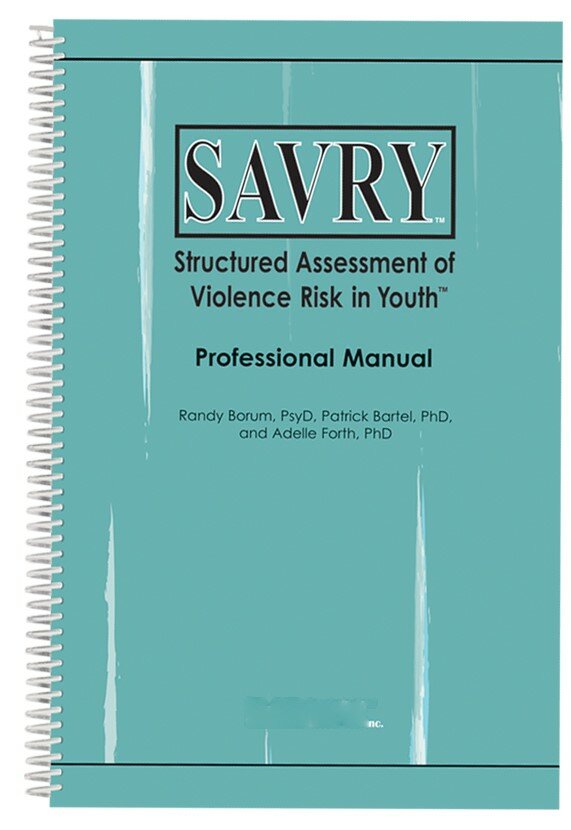Please specify the quantity of product(s).





Structured Assessment of Violence Risk in Youth (SAVRY)
| Item | Product | Price | QTY |
|---|---|---|---|
| 32801 | Structured Assessment of Violence Risk in Youth (SAVRY) Kit | $186.00 | |
| 32801M | SAVRY Manual | $83.00 | |
| 32801R | SAVRY Rating Forms, Pk/50 | $109.00 |
A valuable assessment for intervention/supervision plans concerning violence risk in youth.
Randy Borum, Psy. D., Patrick Bartel, Ph. D. and Adelle Forth, Ph. D.
- Age Range: 12-18 years
- Time: 10-15 minutes
- Restricted Use: Levels S or B
The SAVRY is a systematic assessment, in which primary domains of known risk, and protective factors, are addressed, and operational definitions are provided. It is empirically grounded, with items based on the best available research, and guidelines for juvenile risk assessment practice.
These risk and protective factors are based on their relationship to other adolescents, not children or adults. Items have direct implications for treatment, including the consideration of dynamic factors that can be useful targets for intervention in risk reduction.
With its emphasis on dynamic factors, the SAVRY is useful in intervention planning and ongoing progress monitoring, including the formulation of clinical treatment plans, conditions of community supervision, or release/discharge. It allows for consideration of case-specific factors, along with those factors derived from research.
The SAVRY is composed of 24 items in three risk domains drawn from existing research, and the professional literature on adolescent development, as well as violence and aggression in youth. The three domains include:
- Historical Risk Factors
- Social/Contextual Risk Factors
- Individual Risk Factors
Each risk item has structure with specific rating guidelines (Low, Moderate of High). In additional to the 24 risk items, the SAVRY also includes six Protective Factor items that are rated as “Present” or “Absent”.
The SAVRY is not designed to be a formal test or scale; there are no assigned numerical values, nor are there any specified cutoff scores. Based on the Structured Professional Judgment (SPJ) model, the SAVRY structures an assessment to that important factors will be incorporated when formulating a final professional judgment about a youth’s level of risk.
Interrater reliability for the SAVRY, using trained student raters (intraclass correlation coefficient) was .81 for the SAVRY Risk Score, and .77 for the Summary Risk Rating.
In the initial validation study, the SAVRY Risk Total correlated significantly with the Youth Level of Service/Case Management Inventory (YLS/CMI) and the Hare Psychopathy Checklist:Youth Version (PCL:YV) among offenders .89 and .78 respectively. The SAVRY Protective Factors , as a whole, were negatively correlated with both of these measures.
Significant correlations have been found in other studies between the SAVRY Risk Total Scores and measures of violence among young male offenders in Canada (.32 in one study and .25 in another) among high-risk Native American youth (.56 for sample, .72 for females; Fitch, 2002).
| Risk Item/Factors | Items/Factors included in the SAVRY |
| Historical Risk Factors | - History of Violence - History of Nonviolent Offending - Early initiation of Violence - Past Supervision/Intervention Failures - History of Self-Harm or Suicide Attempts - Exposure to Violence in the Home - Childhood History of Maltreatment - Parental/Caregiver Criminality - Early Caregiver Disruption - Poor School Achievement |
| Social and Contextual Risk Factors |
- Poor Delinquency - Peer Rejection - Stress and Poor Coping - Poor Parental Management - Lack of Personal/Social Support - Community Disorganization |
| Individual/Clinical Risk Factors |
- Negative Attitudes - Risk Taking/Impulsivity - Substance-Use Difficulties - Anger Management Problems - Low Empathy/Remorse - Attention Deficit/Hyperactivity Difficulties - Poor Compliance - Low Interest/Commitment to School |
| Protective Factors | - Prosocial Involvement - Strong Social Support - Strong Attachments and Bonds - Positive Attitude Toward Intervention and Authority - Strong Commitment to School - Resilient Personality Traits |
The SAVRY Kit includes the Manual and 50 Rating Forms.
